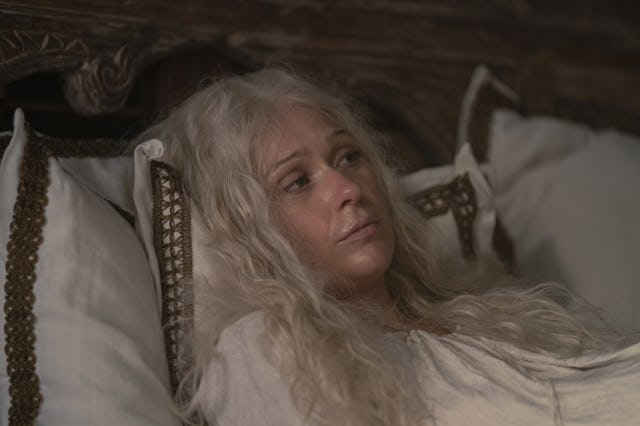'House Of The Dragon' Debuts With Horrific Birth Scene
The 'Game of Thrones' prequel's creators defended the scene in interviews about the pilot episode.

The long-awaited prequel series of Game of Thrones — titled House of the Dragon and following the Targaryen dynasty — debuted on Sunday night to solid reviews from critics and fans alike. But there was one gruesome scene in the HBO series that had viewers questioning their loyalty to the fantasy franchise.
Halfway through the pilot episode, King Viserys Targareyen (Paddy Considine), desperately hoping for a male heir, chooses to sacrifice his pregnant wife, Aemma Arynn (Sian Brooke), to save their unborn child, who is in breech position. In modern terms, Aemma is forced into a C-section after her baby is unable to be manually turned head-first in the uterus.
The queen screams in anguish as she is held down and cut open by doctors and midwives who’ve never done the procedure before — nothing but “milk of the poppy” serving as a painkiller and anesthetic. After making the decision without every consulting her, Viserys tries to console his frightened wife, who begs him to stop the doctors. (To make matters worse, the mother is grieving after multiple miscarriages and stillbirths.)
As Aemma bleeds out, their child is born — a son named Baelon Targaryen. Yet, the baby boy dies mere hours after his mother, leaving the king — and his teenage daughter, Rhaenyra (Milly Alcock), distraught.
It’s all quite devastating, and triggering for those who may have experienced any loss in childbirth or those who have had traumatic births.
Viserys (Paddy Considine) beside Aemma (Sian Brooke) during the scene.
Show creator Ryan Condal said the scene was a way to give insight into the character of Viserys — who “was an active participant in what happened to Aemma and to Baelon” — while showing the violence of childbirth in medieval history.
“It's not meant to be gratuitous. It's meant to show there's a heavy theme in this particular period,” he told Vanity Fair. “In Fire and Blood, there's a lot of very difficult births. It was something we wanted to carry over the season. There's this whole idea in Game of Thrones, or in the Middle Ages, or in historical age like this, that the men marched off to the battlefield and the women's battlefield happened in the child bed. That was a very dangerous place to be. All of the complications that people go through in modern birth that are now fixed by science and medicine and surgery were not really possible back then. Any slight complication, anything could lead to very tragic consequences for the child and the mother.”
He continued, “We think you see plenty of violence of all colors in Westeros, but there is a particular violence to childbirth, even childbirth that goes well in the end. We wanted to dramatize that.”
George R.R. Martin — who assisted Condal with the episode and wrote the book, Fire and Blood, on which the series is based — added that although the birth scene is very disturbing, it is also “incredibly powerful.”
“It’s visceral and it’ll rip your heart out and throw it on the floor,” he said. “It has the kind of impact that the Red Wedding [from Game of Thrones Season 3] had. It’s a beautifully done scene of something horrible.”
Sian Brooke, who played Aemma with dignity, also shared her thoughts on the heartbreaking scene, which she called a “bloodbath.”
In an interview with Variety, Brooke said she tapped into her own experience as a mother of two to bring authenticity to the moment, and actually lost her voice from screaming so much during the two-day shoot.
“Thank goodness for modern medicine,” she said. “Going into labor, you do feel like you’ve been in some sort of battle by the end of it, because every ounce of you goes into it. But it’s much worse in those times.”
The British actress also spoke of how powerful the scene is in light of the recent Roe v. Wade reversal and the lack of abortion rights in the U.S.
“Now, you realize how shocking that is, that comparisons can be made between present day, and a woman’s body and the right to choose what happens to her body, and thousands of years ago,” she said.” I just think the fact that we’re even talking about it, is evident in itself. It’s very poignant what can happen within a year, and how far we can step back.”
In happier news, House of the Dragon — which airs Sundays at 9 p.m. on HBO and HBO Max — is just as, or perhaps more, female-focused than its predecessor as it follows the journey of Viserys and Aemma’s daughter and heir, Rhaenerya, as she attempts to ascend to the Iron Throne.